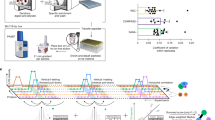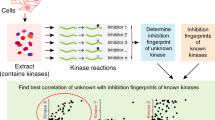Abstract
Mitogen-activated protein kinase (MAPK) pathways form the backbone of signal transduction in the mammalian cell. Here we applied a systematic experimental and computational approach to map 2,269 interactions between human MAPK-related proteins and other cellular machinery and to assemble these data into functional modules. Multiple lines of evidence including conservation with yeast supported a core network of 641 interactions. Using small interfering RNA knockdowns, we observed that approximately one-third of MAPK-interacting proteins modulated MAPK-mediated signaling. We uncovered the Na-H exchanger NHE1 as a potential MAPK scaffold, found links between HSP90 chaperones and MAPK pathways and identified MUC12 as the human analog to the yeast signaling mucin Msb2. This study makes available a large resource of MAPK interactions and clone libraries, and it illustrates a methodology for probing signaling networks based on functional refinement of experimentally derived protein-interaction maps.
This is a preview of subscription content, access via your institution
Access options
Subscribe to this journal
Receive 12 print issues and online access
$259.00 per year
only $21.58 per issue
Buy this article
- Purchase on Springer Link
- Instant access to full article PDF
Prices may be subject to local taxes which are calculated during checkout



Similar content being viewed by others
References
Chang, L. & Karin, M. Mammalian MAP kinase signalling cascades. Nature 410, 37–40 (2001).
Widmann, C., Gibson, S., Jarpe, M.B. & Johnson, G.L. Mitogen-activated protein kinase: conservation of a three-kinase module from yeast to human. Physiol. Rev. 79, 143–180 (1999).
Kolch, W., Calder, M. & Gilbert, D. When kinases meet mathematics: the systems biology of MAPK signalling. FEBS Lett. 579, 1891–1895 (2005).
Johnson, G.L. & Lapadat, R. Mitogen-activated protein kinase pathways mediated by ERK, JNK, and p38 protein kinases. Science 298, 1911–1912 (2002).
Kolch, W. Coordinating ERK/MAPK signalling through scaffolds and inhibitors. Nat. Rev. Mol. Cell Biol. 6, 827–837 (2005).
Johnson, S.A. & Hunter, T. Kinomics: methods for deciphering the kinome. Nat. Methods 2, 17–25 (2005).
Reszka, A.A., Seger, R., Diltz, C.D., Krebs, E.G. & Fischer, E.H. Association of mitogen-activated protein kinase with the microtubule cytoskeleton. Proc. Natl. Acad. Sci. USA 92, 8881–8885 (1995).
Olsen, J.V. et al. Global, in vivo, and site-specific phosphorylation dynamics in signaling networks. Cell 127, 635–648 (2006).
Friedman, A. & Perrimon, N. A functional RNAi screen for regulators of receptor tyrosine kinase and ERK signalling. Nature 444, 230–234 (2006).
Venkatesan, K. et al. An empirical framework for binary interactome mapping. Nat. Methods 6, 83–90 (2009).
Karin, M. The regulation of AP-1 activity by mitogen-activated protein kinases. J. Biol. Chem. 270, 16483–16486 (1995).
Rothe, M., Sarma, V., Dixit, V.M. & Goeddel, D.V. TRAF2-mediated activation of NF-kappa B by TNF receptor 2 and CD40. Science 269, 1424–1427 (1995).
Whitmarsh, A.J. & Davis, R.J. Structural organization of MAP-kinase signaling modules by scaffold proteins in yeast and mammals. Trends Biochem. Sci. 23, 481–485 (1998).
Hayashi, K. & Altman, A. Filamin A is required for T cell activation mediated by protein kinase C-theta. J. Immunol. 177, 1721–1728 (2006).
Hooley, R., Yu, C.Y., Symons, M. & Barber, D.L. G alpha 13 stimulates Na+-H+ exchange through distinct Cdc42-dependent and RhoA-dependent pathways. J. Biol. Chem. 271, 6152–6158 (1996).
Baumgartner, M., Patel, H. & Barber, D.L. Na(+)/H(+) exchanger NHE1 as plasma membrane scaffold in the assembly of signaling complexes. Am. J. Physiol. Cell Physiol. 287, C844–C850 (2004).
Karydis, A., Jimenez-Vidal, M., Denker, S.P. & Barber, D.L. Mislocalized scaffolding by the Na-H exchanger NHE1 dominantly inhibits fibronectin production and TGF-beta activation. Mol. Biol. Cell 20, 2327–2336 (2009).
Wang, D., Li, Z., Messing, E.M. & Wu, G. Activation of Ras/Erk pathway by a novel MET-interacting protein RanBPM. J. Biol. Chem. 277, 36216–36222 (2002).
Kelley, B.P. et al. Conserved pathways within bacteria and yeast as revealed by global protein network alignment. Proc. Natl. Acad. Sci. USA 100, 11394–11399 (2003).
Cullen, P.J. et al. A signaling mucin at the head of the Cdc42- and MAPK-dependent filamentous growth pathway in yeast. Genes Dev. 18, 1695–1708 (2004).
Collin, L., Schlessinger, K. & Hall, A. APC nuclear membrane association and microtubule polarity. Biol. Cell 100, 243–252 (2008).
Kim, J. et al. Functional genomic screen for modulators of ciliogenesis and cilium length. Nature 464, 1048–1051 (2010).
Konig, R. et al. Human host factors required for influenza virus replication. Nature 463, 813–817 (2010).
Konig, R. et al. Global analysis of host-pathogen interactions that regulate early-stage HIV-1 replication. Cell 135, 49–60 (2008).
Gunsalus, K.C. et al. Predictive models of molecular machines involved in Caenorhabditis elegans early embryogenesis. Nature 436, 861–865 (2005).
Lunardi, A. et al. A genome-scale protein interaction profile of Drosophila p53 uncovers additional nodes of the human p53 network. Proc. Natl. Acad. Sci. USA 107, 6322–6327 (2010).
LaCount, D.J. et al. A protein interaction network of the malaria parasite Plasmodium falciparum. Nature 438, 103–107 (2005).
Qi, M. & Elion, E.A. MAP kinase pathways. J. Cell Sci. 118, 3569–3572 (2005).
Bader, G.D. et al. BIND–the biomolecular interaction network database. Nucleic Acids Res. 29, 242–245 (2001).
Peri, S. et al. Development of human protein reference database as an initial platform for approaching systems biology in humans. Genome Res. 13, 2363–2371 (2003).
Reguly, T. et al. Comprehensive curation and analysis of global interaction networks in Saccharomyces cerevisiae. J. Biol. 5, 11 (2006).
Ptacek, J. et al. Global analysis of protein phosphorylation in yeast. Nature 438, 679–684 (2005).
Gavin, A.C. et al. Functional organization of the yeast proteome by systematic analysis of protein complexes. Nature 415, 141–147 (2002).
Ito, T. et al. A comprehensive two-hybrid analysis to explore the yeast protein interactome. Proc. Natl. Acad. Sci. USA 98, 4569–4574 (2001).
Ho, Y. et al. Systematic identification of protein complexes in Saccharomyces cerevisiae by mass spectrometry. Nature 415, 180–183 (2002).
Uetz, P. et al. A comprehensive analysis of protein-protein interactions in Saccharomyces cerevisiae. Nature 403, 623–627 (2000).
Chanda, S.K. et al. Genome-scale functional profiling of the mammalian AP-1 signaling pathway. Proc. Natl. Acad. Sci. USA 100, 12153–12158 (2003).
Konig, R. et al. A probability-based approach for the analysis of large-scale RNAi screens. Nat. Methods 4, 847–849 (2007).
Denker, S.P., Huang, D.C., Orlowski, J., Furthmayr, H. & Barber, D.L. Direct binding of the Na–H exchanger NHE1 to ERM proteins regulates the cortical cytoskeleton and cell shape independently of H(+) translocation. Mol. Cell 6, 1425–1436 (2000).
Acknowledgements
We thank R. Kelley, S. Suthram and G. Warner for assistance on various aspects of this work. This work was supported by the US National Institutes of Health (R01-GM070743, R01-GM47413 and P30-MH062261) and Unilever PLC.
Author information
Authors and Affiliations
Contributions
S.B., R.B., S.S. and T.I. conceived the study; C.-y.C., J.S., S.W., R.B., C.K. and C.H.M. performed the experiments; S.B., M.G. and M.S. analyzed the data; S.B., T.I., S.S., D.L.B. and S.K.C. wrote the paper and guided the study.
Corresponding authors
Ethics declarations
Competing interests
R.B. is a shareholder of Prolexys Pharmaceuticals, Inc. S.S. is an employee, scientific founder and shareholder of Prolexys Pharmaceuticals Inc.
Supplementary information
Supplementary Text and Figures
Supplementary Figures 1–3 and Supplementary Tables 3,5,7 (PDF 534 kb)
Supplementary Table 1
List of binary Y2H interactions including annotations. (XLS 457 kb)
Supplementary Table 2
Core high-confidence MAPK Y2H interactions. (XLS 96 kb)
Supplementary Table 4
List of 134 triplets containing two or more interactions from the core MAPK Y2H network. (XLS 42 kb)
Supplementary Table 6
List of human protein-protein interactions used as a reference set and for module finding. (XLS 1784 kb)
Rights and permissions
About this article
Cite this article
Bandyopadhyay, S., Chiang, Cy., Srivastava, J. et al. A human MAP kinase interactome. Nat Methods 7, 801–805 (2010). https://doi.org/10.1038/nmeth.1506
Received:
Accepted:
Published:
Issue Date:
DOI: https://doi.org/10.1038/nmeth.1506
This article is cited by
-
A fly GWAS for purine metabolites identifies human FAM214 homolog medusa, which acts in a conserved manner to enhance hyperuricemia-driven pathologies by modulating purine metabolism and the inflammatory response
GeroScience (2022)
-
Engineering digitizer circuits for chemical and genetic screens in human cells
Nature Communications (2021)
-
A novel variant in C5ORF42 gene is associated with Joubert syndrome
Molecular Biology Reports (2020)
-
β-Thujaplicin induces autophagic cell death, apoptosis, and cell cycle arrest through ROS-mediated Akt and p38/ERK MAPK signaling in human hepatocellular carcinoma
Cell Death & Disease (2019)
-
Functional identity of hypothalamic melanocortin neurons depends on Tbx3
Nature Metabolism (2019)



